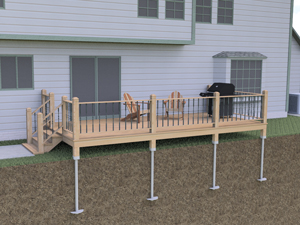Selecting the Right Deck Footings for Stability and Resilience
The durability and safety and security of your deck depend heavily on the kind of grounds you choose, as they give the necessary support and stability to withstand the test of time. In this discussion, we will check out the various kinds of deck footings, think about the vital aspects to consider when making a decision, and delve right into the pros and cons of various alternatives.
Types of Deck Footings
There are a number of kinds of deck grounds that can be used, each offering distinct benefits and considerations. One typical kind of ground is the concrete pier ground. These footings consist of a cylindrical hole full of concrete, which offers a strong structure for the deck messages. Concrete pier grounds are relatively very easy to set up and offer excellent security, making them a prominent choice for several deck jobs.
These grounds are installed by screwing them into the ground, which produces a protected foundation for the deck. They also allow for very easy change and leveling of the deck if needed.
Additionally, some builders choose precast concrete footings. These grounds are made from long lasting concrete and come in various forms and dimensions to accommodate different deck layouts. Precast concrete grounds are hassle-free to install and offer a stable base for the deck structure.
Finally, one more alternative is the post-in-anchor footing system. This kind of ground involves driving a metal anchor right into the ground and attaching it to the deck blog post. It provides adaptability in terms of positioning the deck articles and is ideal for decks with lightweight structures.
When choosing the best kind of deck footing, it is important to take into consideration aspects such as soil problems, deck lots, and local building regulations (Deck Footings). Consulting with an expert service provider or structural designer can assist make certain the appropriate ground is selected for a steady and secure deck
Factors to Take Into Consideration When Picking Grounds
When picking the appropriate footings for a deck, it is critical to meticulously consider various variables such as soil problems, deck tons, and adherence to neighborhood building regulations. These variables play a significant duty in guaranteeing the stability and longevity of the deck framework.
Among the main factors to take into consideration is the soil problems. The kind of soil on which the deck will be constructed determines the kind of footings required. Decks built on loose or sandy soils might call for deeper grounds to supply ample assistance and protect against settling. On the various other hand, decks improved clay or expansive dirts might require footings that can fit the soil's tendency to increase and agreement.
An additional important factor is the deck lots. The weight of the deck, including the materials used and any kind of prospective real-time lots such as furniture or gatherings, must be taken right into account when choosing grounds. The grounds must be designed to bear the weight of the deck and distribute it equally to stop any kind of structural issues or failings.
Finally, adherence to neighborhood building regulations is vital. Structure codes differ from region to area, and it is important to conform with the certain requirements established by the neighborhood authorities. Deck Footings. These codes ensure that the deck is constructed safely and satisfies the essential standards for architectural stability and load-bearing ability
Concrete Grounds: Cons and pros

Concrete footings offer several benefits and negative aspects when made use of as click this the foundation for a deck. On the favorable side, concrete footings give excellent security and sturdiness.
One more advantage of concrete footings is their convenience. They can be poured right into different sizes and shapes to accommodate different deck layouts and configurations. Concrete footings can be tailored to fit the certain demands and demands of the deck framework.
Nonetheless, there are likewise some drawbacks to using concrete grounds. One significant downside is the price and labor associated with their setup. Concrete footings call for excavation and frequently need the aid of hefty equipment. This can raise the overall expense of the deck project and might call for expert aid.

Helical Piers Vs. Sonotubes: Which Is Much better?
In considering the structure options for a deck, the comparison in between helical piers and sonotubes is vital in identifying the remarkable option. They are twisted into the ground making use of hydraulic equipment, providing a long lasting and stable structure for the deck.
When it pertains to stability and resilience, helical piers have the top hand. The helical plates on the piers produce a strong grasp with the soil, avoiding any type of movement or changing of the deck. This is especially useful in locations with unstable or changing dirt conditions. Sonotubes, on the other hand, count exclusively on the concrete filling up for security, which may not provide the very same degree of toughness and resistance.
In regards to installation, helical piers are fairly less complicated and faster to set up contrasted to sonotubes. The hydraulic machinery used to twist the piers right into the ground makes sure a quick and effective procedure. Sonotubes, on the various other hand, need excavating holes and putting concrete, which can be labor-intensive and lengthy.
Furthermore, helical piers are a more functional option. They can be used in various soil problems and can be view website changed or strengthened if needed. Sonotubes, on the various other hand, may call for extra support, such as rebar, in certain dirt conditions or areas with high tons requirements.
Picking the Right Footings for Your Deck's Dimensions
For optimal structural honesty, it is important to thoroughly select the suitable footings that line up with the measurements of your deck. The measurements of your deck, including its width, height, and length, play a substantial duty in identifying the kind and size of grounds needed.
When selecting grounds for your deck, it is important to think about the load-bearing capacity of the dirt. The weight of the deck, incorporated with the weight of any type of furnishings or individuals on it, exerts a significant pressure on the grounds (Deck Footings). Consequently, it is crucial to choose grounds that can adequately sustain this weight without sinking or changing in time.
The shapes and size of the footings should additionally be taken into consideration. Bigger decks with greater measurements call for larger footings to give adequate stability and assistance. The shape of the footings, whether they are round or square, depends upon the design and design of the deck. Furthermore, the depth at which the grounds are installed should be established based on the frost line in your region to avoid any kind of heaving or shifting due to freezing temperature levels.
Conclusion
Finally, choosing the ideal deck footings is critical for making sure stability and durability. Aspects such as the kind of footings, the deck's measurements, and the benefits and drawbacks of various options must be taken into consideration. Concrete footings use strength and durability, yet may be a lot more lengthy and pricey to install. Helical piers and sonotubes have their very own benefits and drawbacks. Inevitably, selecting the suitable grounds for your deck's details requirements is necessary for a resilient and effective structure.
These grounds consist of a cylindrical visit their website opening filled with concrete, which provides a solid foundation for the deck blog posts. Concrete pier grounds are relatively easy to install and offer outstanding stability, making them a prominent option for numerous deck jobs.
Precast concrete grounds are practical to set up and give a secure base for the deck framework.
It supplies flexibility in terms of positioning the deck messages and is suitable for decks with light-weight structures.
Concrete footings offer a number of benefits and drawbacks when used as the structure for a deck.